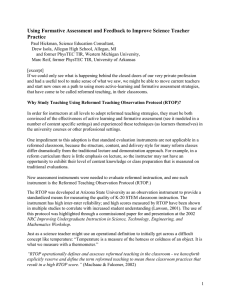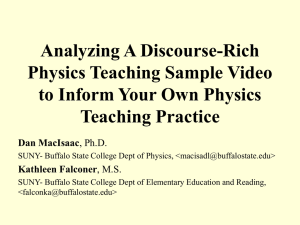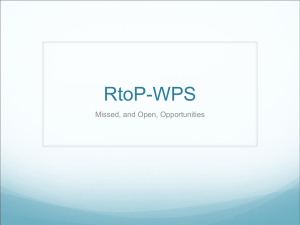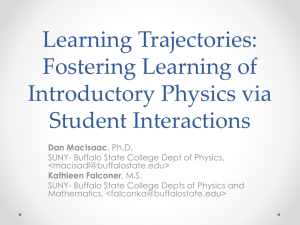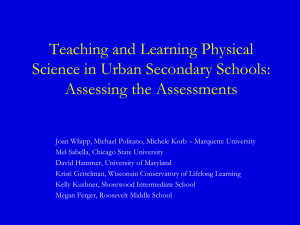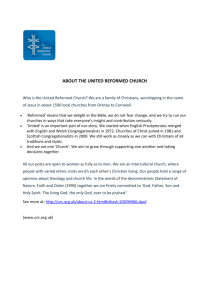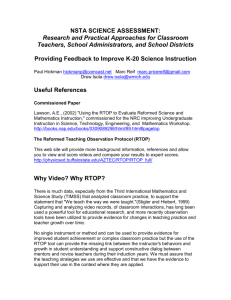Document 15637654
advertisement
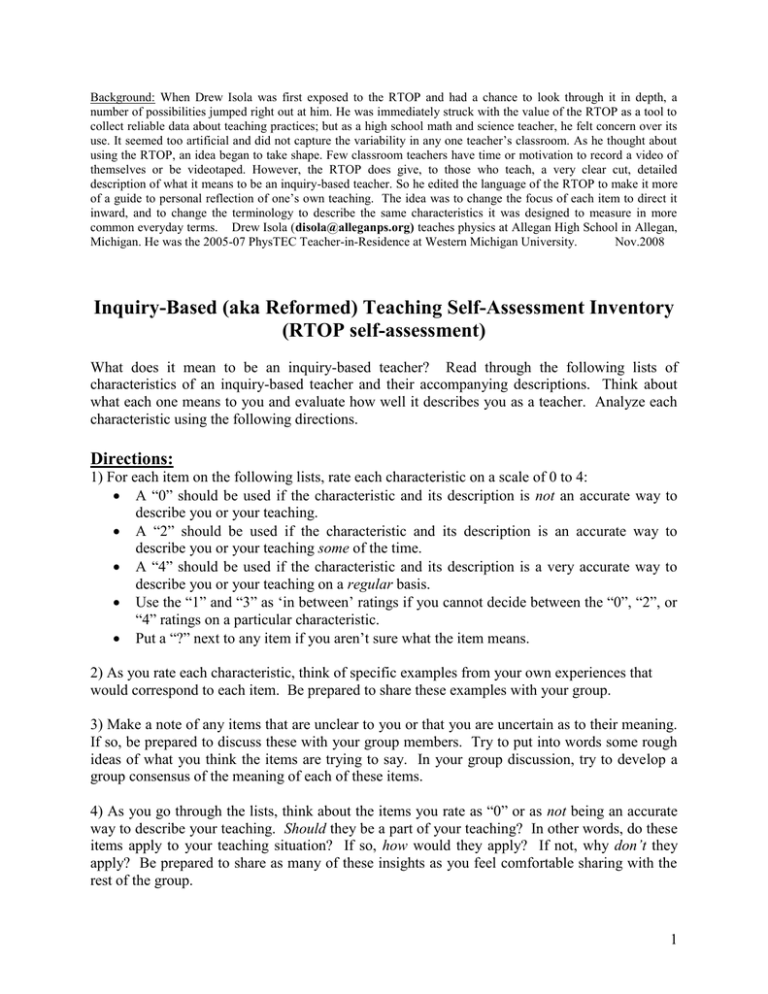
Background: When Drew Isola was first exposed to the RTOP and had a chance to look through it in depth, a number of possibilities jumped right out at him. He was immediately struck with the value of the RTOP as a tool to collect reliable data about teaching practices; but as a high school math and science teacher, he felt concern over its use. It seemed too artificial and did not capture the variability in any one teacher’s classroom. As he thought about using the RTOP, an idea began to take shape. Few classroom teachers have time or motivation to record a video of themselves or be videotaped. However, the RTOP does give, to those who teach, a very clear cut, detailed description of what it means to be an inquiry-based teacher. So he edited the language of the RTOP to make it more of a guide to personal reflection of one’s own teaching. The idea was to change the focus of each item to direct it inward, and to change the terminology to describe the same characteristics it was designed to measure in more common everyday terms. Drew Isola (disola@alleganps.org) teaches physics at Allegan High School in Allegan, Michigan. He was the 2005-07 PhysTEC Teacher-in-Residence at Western Michigan University. Nov.2008 Inquiry-Based (aka Reformed) Teaching Self-Assessment Inventory (RTOP self-assessment) What does it mean to be an inquiry-based teacher? Read through the following lists of characteristics of an inquiry-based teacher and their accompanying descriptions. Think about what each one means to you and evaluate how well it describes you as a teacher. Analyze each characteristic using the following directions. Directions: 1) For each item on the following lists, rate each characteristic on a scale of 0 to 4: A “0” should be used if the characteristic and its description is not an accurate way to describe you or your teaching. A “2” should be used if the characteristic and its description is an accurate way to describe you or your teaching some of the time. A “4” should be used if the characteristic and its description is a very accurate way to describe you or your teaching on a regular basis. Use the “1” and “3” as ‘in between’ ratings if you cannot decide between the “0”, “2”, or “4” ratings on a particular characteristic. Put a “?” next to any item if you aren’t sure what the item means. 2) As you rate each characteristic, think of specific examples from your own experiences that would correspond to each item. Be prepared to share these examples with your group. 3) Make a note of any items that are unclear to you or that you are uncertain as to their meaning. If so, be prepared to discuss these with your group members. Try to put into words some rough ideas of what you think the items are trying to say. In your group discussion, try to develop a group consensus of the meaning of each of these items. 4) As you go through the lists, think about the items you rate as “0” or as not being an accurate way to describe your teaching. Should they be a part of your teaching? In other words, do these items apply to your teaching situation? If so, how would they apply? If not, why don’t they apply? Be prepared to share as many of these insights as you feel comfortable sharing with the rest of the group. 1 Lesson Planning and Implementation: 1) Your instructional strategies and activities show respect for students’ prior knowledge and their preconceptions or misconceptions found within that knowledge. A cornerstone of “reformed teaching” is taking into consideration the prior knowledge that students bring with them. The term “respect” is pivotal in this item. It suggests an attitude of curiosity on the teacher’s part, an active solicitation of student ideas, and an understanding that much of what a student brings to the mathematics or science classroom is strongly shaped and conditioned by their everyday experiences. 0 1 2 3 4 ______________________________________________________________________________ ______________________________________________________________________________ ______________________________________________________________________________ 2) Your instructional strategies and activities are designed to allow students to use their prior knowledge to explain or predict phenomena and then resolve any results or answers that are surprising to them. A common phrase used to describe strategies designed to change student thinking in this way is “cognitive conflict”. Students need to be given opportunities to explore and apply the knowledge they bring to class with them. Research tells us that students will build new concepts on the concepts they already have, so they need time to figure out the usefulness of the knowledge they have and where it is no longer sufficient. Your instructional strategies and activities should encourage students to expand on existing knowledge, construct new knowledge while connecting it to previous knowledge, and sometimes radically rearrange their thinking to accommodate new explanations that they may not have encountered before. One must be careful however not to subject students to situations or problems where their predictions or explanations are frequently inadequate or wrong. In these environments students frequently give up trying to build their own understanding and just wait for someone to tell them the correct answer. 0 1 2 3 4 ______________________________________________________________________________ ______________________________________________________________________________ ______________________________________________________________________________ 2 3) In your lessons, student exploration precedes formal presentation. Reformed teaching allows students to build complex abstract knowledge from simpler, more concrete experience. This suggests that any formal presentation of content should be preceded by student exploration. In planning your lessons, there should be a consistent focus on how to give students simple, concrete experiences with the concepts involved before attempting to synthesize them into a complex, more abstract picture. An interesting side note on this issue is that this does not imply the converse...that all exploration should be followed by a formal presentation of content. For some students, just the exposure to simple, concrete mathematical and scientific ideas/phenomena is sufficient for their level. This allows future teachers to build on prior knowledge and experiences initiated by you. 0 1 2 3 4 ______________________________________________________________________________ ______________________________________________________________________________ ______________________________________________________________________________ 4) The focus and direction of your lessons are often determined by ideas or questions originating from students. If students are members of a true learning community, and if divergence of thinking is valued, then the direction that a lesson takes cannot always be predicted in advance. Thus, planning and executing a lesson may include contingencies for building upon the unexpected. A lesson that met this criterion might not end up where it appeared to be heading at the beginning. Your lesson plans should be constructed to allow for this. This item implies not only that the flow of the lesson is often influenced or shaped by student contributions, but that once a direction is in place, students are crucial in sustaining and enhancing the momentum of the lesson through their ideas and suggestions. More experienced teachers may have a variety of possible conceptual paths mapped out through the material based on their previous experiences with teaching the same concepts. But even experienced teachers should be prepared to deviate from any of their prepared lesson plans if a conceptual window opens, as a result of input from the students, which allows them to effectively teach something. Keeping an eye out for that “teachable moment” is a key component of this characteristic. 0 1 2 3 4 ______________________________________________________________________________ ______________________________________________________________________________ ______________________________________________________________________________ 3 5) The focus and direction of your lesson is often determined by various types of formative assessments. The use of formative assessment, or frequent checks for student understanding, is a key component of reformed teaching. Assessment should be viewed as more than just a means to generate grades. It is a learning tool for the student to demonstrate what they know and it is a learning tool for the teacher to determine what the students need to do next. The results of these types of assessments give teachers feedback on whether they can move on into new conceptual territory or need to refine and re-teach concepts they thought they had covered adequately. Notice the use of the phrase “various types”. Reformed teaching makes use of a wide range of assessment tools from informal discussions to more formal methods of assessment, from written to purely verbal feedback from students, and from individual to group activities. 0 1 2 3 4 ______________________________________________________________________________ ______________________________________________________________________________ ______________________________________________________________________________ 6) Your lesson plans, and the questions you pose, encourage students to seek and value different ways to investigate or solve a problem. Divergent thinking is an important part of mathematical and scientific reasoning. A lesson that accomplishes this goal would not insist on only one method of experimentation or one approach to solving a problem. A teacher who valued alternative modes of thinking would respect and actively solicit a variety of approaches, and understand that there may be more than one answer to a question. Such a teacher would not hinder or confine students’ attempts to solve problems or investigate ideas in ways that are different from their own. This further suggests that the teacher’s questions should help to open up conceptual space rather than confining it within predetermined boundaries. In its simplest form, teacher questioning triggers divergent modes of thinking by posing problems for which there may be more than one correct answer or presenting phenomena that can have more than one valid interpretation. 0 1 2 3 4 ______________________________________________________________________________ ______________________________________________________________________________ ______________________________________________________________________________ 4 7) Your lessons are designed to engage students as members of a “learning community”, intellectual rigor, constructive criticism, and the challenging of ideas are valued. Much knowledge is constructed through social interactions. The setting within which this process occurs has been called a “learning community”, an example of which is the use of the term community in the phrase “the scientific community”. Similar to the way scientists and mathematicians interact, students should participate actively as knowledge is negotiated within the community. There is a give and take among members of the community in the determination of what knowledge is generally accepted and what knowledge is rejected. At the heart of mathematical and scientific endeavors is rigorous debate. In your class, this would be achieved by allowing a variety of ideas to be presented in a variety of settings (one-on-one, small group, class discussion), but insisting that challenge and negotiation also occur. Accepting a variety of proposals or ideas from students without accompanying evidence or argument is not sufficient to satisfy this characteristic. It is important to remember that a group of learners in one room together does not necessarily constitute a “learning community.” 0 1 2 3 4 ______________________________________________________________________________ ______________________________________________________________________________ ______________________________________________________________________________ 5 Content Knowledge: This section focuses on the depth of conceptual understanding of the content by both the teacher and the student along with some recognition of the relative importance of the basic concepts of the content area. It also focuses on the connections with the content taught and other disciplines as well as with real-world situations and phenomena. 8) Your lessons focus on fundamental concepts of the subject. The emphasis on “fundamental” concepts indicates that there are always some significant scientific or mathematical ideas at the heart of each lesson. For example, a lesson on the multiplication algorithm can be anchored in the distributive property. A lesson on energy could focus on the distinction between heat and temperature. In other words, do each of your lessons have some fundamental science or math concept (or powerful idea) underlying the purpose of the lesson? When students finish a topic, chapter, or unit, is it clear to them what the basic science or math concepts are that they have learned? 0 1 2 3 4 ______________________________________________________________________________ ______________________________________________________________________________ ______________________________________________________________________________ 9) Your lessons promote strongly coherent conceptual understanding. The word “coherent” is used to emphasize the strong inter-relatedness of mathematical and/or scientific thinking. Concepts do not stand on their own two feet. They are increasingly more meaningful as they become connected to and grouped with other concepts. The focus of your lessons should always be on how concepts are similar to and different from other concepts students have learned. Your lessons should make it possible for students to see and explain how the concepts they are learning connect with other math and science concepts. 0 1 2 3 4 ______________________________________________________________________________ ______________________________________________________________________________ ______________________________________________________________________________ 6 10) As a teacher, you have a solid grasp of the subject matter content inherent in the lessons you teach. This indicates that a teacher can sense the potential significance of ideas as they occur in each lesson, even when articulated vaguely by students, and feels comfortable connecting them to fundamental concepts of the subject. Teachers who meet this description are able to see quickly what students are trying to say, how it connects with science or math concepts, and bring up questions, ideas or examples that help the student clarify their own thinking. A solid grasp would be indicated by an eagerness to pursue student’s thoughts even if seemingly unrelated at the moment and not feel inadequate or intimidated by them. The grade-level at which the teacher’s lessons are directed should be taken into consideration when evaluating this item. 0 1 2 3 4 ______________________________________________________________________________ ______________________________________________________________________________ ______________________________________________________________________________ 11) Elements of abstraction (i.e., symbolic representations, theory building) are encouraged when it is important to do so. Conceptual understanding can be facilitated when relationships or patterns are represented in abstract or symbolic ways. Getting students to think about mathematical relationships between ideas in the form of graphs, equations, or numbers; along with cause and effect explanations of those relationships, help students move their understanding from the specific to the general. Not moving toward abstraction can leave students overwhelmed with trees when a forest might help them locate themselves. Being able to help students “see the forest” at the appropriate times is a crucial aspect of this item. For example, students quickly become overwhelmed when they try to memorize a formula or a step-by-step process for every specific situation they are likely to encounter. Helping and encouraging students to follow general guidelines, laws or theories to develop a solution (a model), the way a mathematician or scientist would do, can facilitate learning and raise a student’s understanding to a higher level. 0 1 2 3 4 ______________________________________________________________________________ ______________________________________________________________________________ ______________________________________________________________________________ 7 12) Connections with other content disciplines and/or real world phenomena are explored and valued. Connecting mathematical and scientific content across the disciplines and with real world applications tends to generalize it and make it more coherent. A physics lesson on electricity might connect with the role of electricity in biological systems, or with the wiring systems of a house. A mathematics lesson on proportionality might connect with the nature of light, and refer to the relationship between the height of an object and the length of its shadow. A teacher strong in this area is able to use many different real world phenomena as teaching tools to help students understand basic science and math concepts not just to entertain them or keep their attention. 0 1 2 3 4 ______________________________________________________________________________ ______________________________________________________________________________ ______________________________________________________________________________ Procedural Knowledge: This section focuses on the kinds of processes that students are asked to use to manipulate information, arrive at conclusions, and evaluate knowledge claims. It most closely resembles what is often referred to as mathematical thinking or scientific reasoning. 13) In your class, students use a variety of means (models, drawings, graphs, symbols, concrete materials, manipulatives, lab materials, etc.) to represent phenomena. Multiple forms of representation allow students to use a variety of mental processes to express their ideas, analyze information and to critique their ideas. A “variety” implies that at least two different means are used on a regular basis. Variety also occurs within a given means. For example, several different kinds of graphs could be used, not just one kind. 0 1 2 3 4 ______________________________________________________________________________ ______________________________________________________________________________ ______________________________________________________________________________ 8 14) In your class, students make predictions, conjectures, estimations and/or hypotheses and devise means to test and then validate or reject them. The idea here is that students explicitly state (out loud or in writing) what they think is going to happen before collecting data, making observations, or seeking out answers. The focus here is whether or not students are regularly expected to engage in such questioning as, “I wonder what will happen if……” or “I think the answer should be…..” or “I expect my answer to be approximately….” or “I think that happened because….”. Following this, students should be encouraged to come up with different ways of interpreting the evidence they generate or evidence generated by others. 0 1 2 3 4 ______________________________________________________________________________ ______________________________________________________________________________ ______________________________________________________________________________ 15) In your class, students are actively engaged in thought-provoking activities that often involve the critical assessment of procedures. This implies more than just a classroom full of active students, but that they were also actively thinking about what they are doing and about how what they were doing could clarify the next steps in their investigation. It also means that students have input into how that activity is to occur. Simply following directions in an active manner does not meet the intent of this item. Students can be very active and yet not very aware of what they are doing. It is a common misconception that just because a classroom full of students who are noisy, active, and who appear to be on task that this automatically implies that inquiry-based learning is taking place. Students should be engaged in activities where they must think about what they are doing and why they are doing it while carrying out the activity. Active participation implies agenda-setting and student activity that is both “minds-on” and “hands-on”. 0 1 2 3 4 ______________________________________________________________________________ ______________________________________________________________________________ ______________________________________________________________________________ 9 16) In your class, students are reflective about their learning. Active reflection is a meta-cognitive activity that facilitates learning. Meta-cognition is sometimes referred to as “thinking about thinking.” Teachers can facilitate this type of reflection by providing time and suggesting strategies for students to evaluate their thoughts throughout a lesson; such as, having students reflect back and reconstruct the thought process they used to achieve their current level of understanding. A review conducted by the teacher may not be reflective if it does not induce students to re-examine or re-assess their thinking. Student reflections that start with questions like, “How did I used to think about this?”, “What caused me to change my mind?”, “What made it difficult for me to understand this?”, etc. are some examples of ways to get students to think about their thinking. Sometimes having students explain or demonstrate their new-found understandings to their peers who are still struggling to grasp the same ideas can get students to think about the conditions necessary for their own understanding to take shape. 0 1 2 3 4 ______________________________________________________________________________ ______________________________________________________________________________ ______________________________________________________________________________ 17) The evaluation of students is achieved using a range of summative assessments meant to measure the depth of student understanding and the application thereof. In your classroom, students need to demonstrate more than just a factual recall of information or the implementation of a memorized step-by-step process. Your evaluation of your students should be based on a variety of summative tasks that require the students to demonstrate and explain the depth of their conceptual understanding. They should also be evaluated on their ability to apply what they have learned to problems or situations that are not just duplicates of problems learned in class. Frequently this involves students having to deal with multiple step thought processes. Another key component to effective summative assessment is requiring students to write about their thought processes as part of their explanations or solutions. 0 1 2 3 4 ______________________________________________________________________________ ______________________________________________________________________________ ______________________________________________________________________________ 10 Teacher/Student Communications & Relationships: Communicative interactions in a classroom are an important window into the culture of that classroom. Lessons where teachers characteristically speak and students listen are not “reformed”. It is important that students be heard, and often, and that they communicate with one another, as well as with the teacher. The nature of the communication captures the dynamics of knowledge construction in that community. Notice that the words communication and community have the same root. 18) In your classroom, students are involved in the communication of their ideas to others using a variety of means and media. The intent of this item is to reflect the communicative richness of a classroom that encourages students to contribute to the discourse and to do so in more than a single mode (making presentations, brainstorming, critiquing, listening, making videos, group work, etc.). Notice the difference between this item and item 13. Item 13 refers to representations of knowledge. This item refers to active forms of communication. 0 1 2 3 4 ______________________________________________________________________________ ______________________________________________________________________________ ______________________________________________________________________________ 19) In your classroom, there is a high proportion of student talk and a significant amount of it occurs between and among students. A lesson where a teacher does most of the talking is not “reformed”. This item reflects the need to increase both the amount of student talk and of talk among students that is on topic and not destructive to the learning process. A “high proportion” means that at any time it is just as likely that a student would be talking as that the teacher would be. A “significant amount” suggests that critical portions of your lessons are developed through discourse among students. 0 1 2 3 4 ______________________________________________________________________________ ______________________________________________________________________________ ______________________________________________________________________________ 11 20) In your classroom, there is a climate of respect for what each student has to say. Respecting what others have to say is more than listening politely. Respect also indicates that what others have to say is actually heard and carefully considered. A “reformed” lesson encourages and allows every member of the community to present their ideas and express their opinions, in some form or another, without fear of censure or ridicule. While time constraints may limit a teacher’s ability to give every student the ability to contribute their ideas or opinions on every matter, the key to this item is that every student should feel as if they could contribute on anything they want and that multiple means of contribution are available to, and understood by, every student. 0 1 2 3 4 ______________________________________________________________________________ ______________________________________________________________________________ ______________________________________________________________________________ 21) In general you are approachable and encouraging, both in and out of class. This characteristic is an outward result of an inward belief that significant student learning can take place in a variety of settings and circumstances inside and outside the classroom. Through supportive one-on-one and small group interactions, students can gain the confidence they need to feel as if they can learn what they are expected to learn no matter how difficult it may seem to them. Your success in this role helps students learn to take ownership and initiative in their own learning especially when they can make appropriate contact with you both during class and at other times. Educational interactions outside of traditional educational settings can give students a broader view of learning and of the value of thought provoking and intellectual discussions of an informal nature. 0 1 2 3 4 ______________________________________________________________________________ ______________________________________________________________________________ ______________________________________________________________________________ 12 22) In general you are patient with students. Patience is not the same thing as tolerating unexpected or unwanted student behavior. Rather there is an anticipation that, when given a chance to play itself out, unanticipated behavior can lead, or be redirected, to rich learning opportunities. A long “wait time” is a necessary but not sufficient condition for rating highly on this item. 0 1 2 3 4 ______________________________________________________________________________ ______________________________________________________________________________ 23) You act as a resource person, working to support and enhance student investigations and problem solving. A “reformed” teacher is not there to tell students what to do and how to do it. Much of the initiative is to come from students, and because students have different ideas, the teacher’s support is carefully crafted to the idiosyncrasies of student thinking. The metaphor, “guide on the side” is in accord with this item. Knowing when to answer students’ questions directly and when to use guided questioning to help them answer their own questions is also an important part of this characteristic. Always telling students the “right answer”, or playing the role of “teacher as answer key” can actually hinder student learning. It can keep students from learning to think for themselves or trusting their own thinking. 0 1 2 3 4 ______________________________________________________________________________ ______________________________________________________________________________ 24) The metaphor “teacher as listener” is very characteristic of your classroom. This metaphor describes a teacher who is often found helping students use what they know to construct further understanding. The teacher may indeed talk a lot, but such talk is carefully crafted around understandings reached by actively listening to what students are saying. “Teacher as listener” would be fully in place if “student as listener” was reciprocally engendered. If students feel that they are genuinely being listened to they will be more likely to listen in kind. 0 1 2 3 4 ______________________________________________________________________________ ______________________________________________________________________________ 13 FURTHER DISCUSSION QUESTIONS: After reading these items, rating them based on your own teaching and then discussing them; think about the following questions and be prepared to discuss them in a small group setting. 1) Are there any aspects of “inquiry-based” teaching, as you have always understood this phrase, that you feel are not reflected on this list of characteristics? Describe these missing aspects and describe why they should be included on this list. 2) As a summary to this whole activity, see if you can now further develop, modify, or add on to your own personal description of what it means to be an “inquiry-based” teacher. How is that definition different from what you thought before? How is it similar? BACKGROUND SUMMARY This inventory was adapted primarily from an instrument called the Reformed Teacher Observation Protocol (RTOP). The RTOP is a formal, structured observation method employed by trained observers to score a videotaped lesson. The score is then used as a way to measure the amount of “reformed teaching” that is occurring in a classroom. The RTOP has a high level of reliability and validity and provides education researchers a way to compare the effectiveness of various teaching practices and to correlate such practices with student achievement. The RTOP provides an operational definition of what is meant by “reformed teaching.” The items arise from a rich research-based literature that describes inquiry-oriented standards-based teaching practices in mathematics and science. This inventory is designed for self-assessment of one’s teaching and as a structure to facilitate discussion of the many different aspects of reformed teaching practices. These RTOP-based items have a rich intuitive meaning to mathematics and science educators and therefore provide fertile ground on which to develop thoughtful discussion of effective teaching. This inventory is not meant to be used as an evaluation tool. Since it is predominantly based on self-assessment, any scores or data resulting from this inventory are not a reliable objective measure of an individual’s teaching. That being said, nobody knows more about a specific teacher’s teaching than that teacher. So any teacher who uses these items in an honest and thoughtful way to think about their own teaching can construct their own detailed definition of inquiry-based teaching and how that definition applies to their own situation. For more information on the underlying conceptual and theoretical basis of the RTOP, and reliability and validity data and norms by grade-level and context: Piburn, M., Sawada, D., Falconer, K., Turley, J. Benford, R., Bloom, I. (2000). Reformed Teaching Observation Protocol (RTOP).http://physicsed.buffalostate.edu/AZTEC/rtop/RTOP_full/PDF. References and videos are at http://physicsed.buffalostate.edu/AZTEC/RTOP/RTOP_full/index.htm. A 344-page book with RTOP data: http://acept.asu.edu/final_report/. RTOP listserv: hickmanp@comcast.net 14
